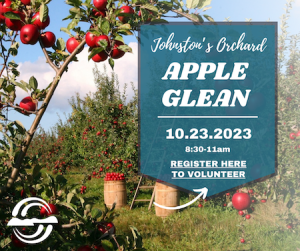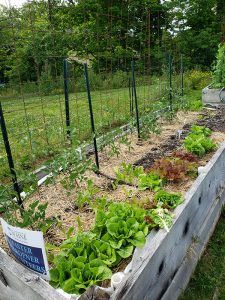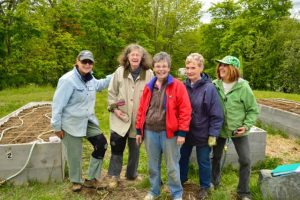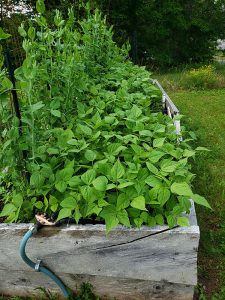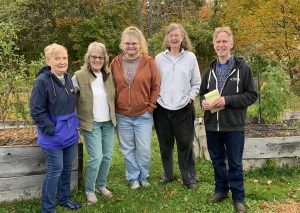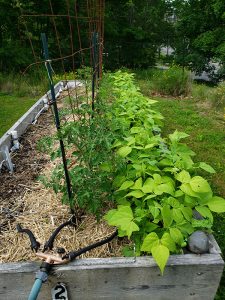Master Gardener Volunteers Newsletter – October 2023
Table of Contents
APPLE GLEANING! / MG PROJECT PROFILE/ PEAT-FREE ARTICLE / CREATING A POLLINATOR GARDEN / MGV PROFILE / ON-LINE TRAININGS AVAILABLE
Upcoming Dates to Remember!
Oct 9th – Extension Office Closed – HOLIDAY
Oct 11th – Maine Hunger Dialogue & Climate Action Summit – see below
Oct 23rd – Apple Gleaning – must register
Nov 8th -9th – Extension Office Closed – Organizational Conference / All Staff
Nov 10th – Extension Office Closed – HOLIDAY
Nov 16th – Planning is underway for our Fall MGV Recognition – SAVE THE DATE
REMINDER!
SAVE THE DATE! Thursday, November 16th – MGV Recognition Event
As the 2023 growing season is wrapping up soon, please remember to Report Your MGV Hours! It is important to report your hours so that new (2022/2023 MGV’s who have completed their coursework and volunteer hours) are presented with their MGV Certificates, and for veteran MGV’s, completing at least 20 hours, to receive end of year earned incentives such as hats, t-shirts, or the super popular Lapel Pins!
APPLE GLEANING! – Register to help today!
This yearly apple picking event is open to all MGV’s who want to come have fun picking apples for a great cause! Let’s fill the food pantries!
When: Monday, October 23rd
Time: 8:30 – 11:00 AM
Where: Johnston’s Apple Orchard, Ellsworth
Rain Date: October 25th
Deadline to register October 13th
REGISTER HERE!
MGV – PROJECT PROFILE ~
Nine Great Seasons for Friends In Action Garden (FIA) – by Jane Ham
“It has been a very rewarding project” remarks Mary Jude. “Many Seniors had home gardens at one time so they have been very appreciative of the variety of fresh vegetables offered to them”.
It all began in 2014 when FIA Executive Director, Jo Cooper, contacted the Cooperative Extension requesting approval for MGV support for a garden at the Moore Center. This new garden would provide vegetables for meals served to Seniors. Mary Jude, new graduate of the MGV training program, long term gardener and experienced working with adults volunteered to spearhead the effort. In spring of 2015 four 4’ by 12’ beds were built by volunteers, Tom Mathews and Steve Keiser. Mary was joined by FIA volunteers Clayton Oliver, Paul and Phyllis Walker, Sharon Mitchell, and Paula Perry. It was mid-season by the time soil testing results were in and amendments were applied. Yet, lettuce, radishes, tomatoes, peas, beans carrots, summer squash, zucchini, kale cabbage and cukes were planted. The yield was good and used for meals and coffee hour.
Over the next couple of seasons Mary was joined by a cadre of dedicated MGV’s; by 2018 the garden was staffed by MGV’s only. The four beds couldn’t produce enough for meals but could supply the Seniors who attended the Thursday morning coffee hour. According to Mary it was a pleasure to meet the Seniors when giving them bags of fresh vegetables to take home.
The MGVs harvested 586 lbs. of vegetables over the nine seasons. Those responsible for the garden are MGV’s Mary Jude and Nancy Adams, Co-Chairs; Rita Buddemeyer, Andrea Ames, Jill Ames, Mary Sweet, Brooks Engle, Roberta Macko, Marie Doyle, Joe Davanzo, and Jane Ham.
There were some challenges including the loss of 2020 season due to COVID. Last fall it became evident the beds would not last much longer. The group contacted the FIA leadership advising that 2023 would be the last season with the existing beds. The beds and soil need to be replaced. Whether FIA decides to renew the project is undetermined at this time.
- Master Gardener Volunteers at the Friends in Action Gardens at the Moore Center in Ellsworth
- Master Gardener Volunteers
Peat-Free for a Healthier Planet – by Betsy Adams
This article has been a long time coming. We have been talking about peat alternatives for a while. It is a huge and somewhat controversial topic. The first part of the article is about the definition and the problems with peat. The second part is about options for home gardeners.
The general definition of peatlands by scientists is a class of wetland with a naturally accumulated layer of dead plant material, or peat, at the surface. Peat is formed when organic matter accumulates faster than it decomposes because of a lack of oxygen in waterlogged matter. In areas where peat accumulation has continued over thousands of years, the land may have layers of peat that are meters thick. Although all peatlands are wetlands, not all wetlands are peatlands. Peatlands cover only 3% of the earth’s surface, but they sequester approximately 30% of soil carbon.
When peat bogs are destroyed by draining and harvesting (more accurately, mining), they release carbon dioxide. Recent research estimates that current global greenhouse gas emissions from drained or burned peatlands account for 5% of all emissions caused by human activity. Harvested and degraded peatlands also reduce biodiversity, water storage, and filtration capacity.
While restoration efforts are underway in many parts of the world, it can take up to 10 years to develop just .04” of peat. That means it can take 1,000 years to form 3 feet of peat. The average depth of a northern peat bog is 4.9’-7.3’. There are no quick fixes.
In England and Wales it will be illegal to sell bagged soils and amendments that contain peat moss as of 2024. They are at least 20 years ahead of us in the effort to reduce the horticultural uses of peat.
While I was researching the vendors for the recent Native Plant Sale at Native Gardens of Blue Hill, I came across Rooted Elements in Montville; they grow all their plants peat-free. Theirs is the only peat-free nursery I could find in Maine. When I decided to write this article, I got in touch with them. I spoke with Amber Lewis and Sara Melanson, the owners. The two women are both lifelong friends and lifelong gardeners; they started their business together in 2021. They took some courses together, including a certificate course in Native Plants and Ecological Horticulture at Coastal Maine Botanical Gardens and were convinced that peat-free was the way for them to go. They began the transition to peat-free in 2022. All of their plants are native to the East and Central US; more than half are native to Maine. They use Organic Mechanics products. Making the switch isn’t always easy, especially with seed starting mixes. Over time, they have tried adding different organic amendments to the Organic Mechanic products, and have settled on a combination of perlite and sand. They are very happy with the health of their plants. An added bonus for their customers is that all their plants are grown from seed and do not touch the soil. That means no jumping worms! They are about to build a shop and nursery center on two acres, but for now you can visit them by appointment.
See links below for more information.
https://www.rootedelements.me/
https://organicmechanicsoil.com/
Organic Mechanic Products are available online at Amazon or directly through the company. They list a couple of places that carry them in Maine, but they were not listed on those companies’ websites. There are other bagged organic peat-free products available, but Organic Mechanics is the only one for which I have personal recommendations.
It’s possible to make your own peat free soil and seed-starting mixes. The article above is by the Hennepin County (Minnesota) Master Gardeners.
An article by the Pew Charitable trusts on Peatland Conservation
Another opinion from Canada: https://vermontcompost.com/resources/using-sphagnum-peat-moss-responsibly
Canadians harvest peat in a more sustainable way, and assert that the growth of Canadian peat moss exceeds the harvest rate. Even with the harvest and restoration processes used in Canada, restoration is less than 80% after 10 years. In any event, all peat moss harvesting releases carbon into the atmosphere and contributes to global warming, as well as reducing species of flora and fauna indigenous only to peat bogs.
Creating a Pollinator Garden: The Essential Checklist – by Lauren Landers
Photos by Linda Dunn
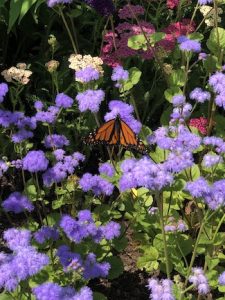
Bees, butterflies and other pollinator populations are on the decline due to habitat loss, the overuse of pesticides and other factors. But every gardener can do their part to help. By growing pollinator-friendly gardens, we can encourage pollinators to make a comeback, safeguard our food systems and preserve the diversity of plants. Even better, pollinator gardens are stunning and they can even be grown in the smallest spaces. After all, a pint-sized window box or porch planter will provide resources for pollinators too!
Four essentials to include in any pollinator garden
Pollinator gardens don’t require a lot of space and they can be built on a budget. But to provide the most benefits for wildlife, all pollinator spaces should include the following 4 elements:
- Food
The best way to attract pollinators is to grow native plants. Native plants are 4 times more attractive to pollinators than non-native species and they’re also easier to take care of. Native plants will vary from state to state, but goldenrod, asters and St. John’s wort are particularly appealing Maine native plants.
asters and St. John’s wort are particularly appealing Maine native plants.
Gardeners should also focus on cultivating nectar and pollen-rich plants, as well as plants with different colors, flower shapes and bloom times. Growing plants that bloom from spring to fall will ensure that pollinators always find something delicious to eat whenever they visit. It’s also wise to include caterpillar host plants like milkweed or buttonbush in landscape designs.
Small space gardeners will often find that flowering herbs, such as dill and sage, or a hummingbird feeder will lure pollinators to even the tiniest backyard!
- Water
Like other animals, pollinators need a ready source of fresh water, especially in summer. Installing a bird bath is one solution; however, bird baths can prove hazardous to small pollinators. For extra pollinator safety, consider adding a misting attachment to your garden hose or place a solar fountain in your bird
bath, which hummingbirds can easily drink from! In small spaces, a simple “bee pool” made with a terracotta saucer, pebbles and fresh water will provide much-needed water for small insects.
- Shelter
Once pollinators arrive in your garden, they’ll need a safe place to sleep and raise their young. Native evergreens and deciduous trees provide excellent shelter for birds and fireflies. On the other hand, solitary native bees often overwinter in old leaf litter, so avoid tidying up your garden too much in the Fall. If gardeners don’t have the space for trees and shrubs, a simple bee hotel can support solitary native bees.
- Safety
Of course, the final element to keeping a pollinator garden is making sure that garden spaces are totally bee safe. That means avoiding pesticides whenever possible and opting for natural pest control options, like companion planting, floating row covers and crop rotation. And don’t forget, performing a Fall garden cleanup and selecting resistant plant cultivars can keep garden pests in check too!
Growing more pollinator gardens is one way to support these amazing species. But if we want to do even more for pollinators, it’s important to increase awareness in our communities. Garden parties, native plant swaps and other community events are great places to spread the word about pollinators and encourage others to build their own pollinator habitat!
Lauren is a member of this year’s class of MGVs. She also writes her own website, https://zerowastehomestead.com/ and writes for Better Homes and Gardens, Readers Digest and a few other websites.
MGV class of 2022/2023 PROFILE ~

Pier Carros
We gather to share
our stories and to create
a community
I wrote this haiku in October 2022, after a meet and greet with other Master Gardener Volunteer trainees from the class of ’22/’23. Later that night, reflecting on conversations at the gathering, I was delighted to discover that I was about to fulfill 2 items on my ‘retirement to do list’. One was to connect with a community of interesting and motivated people and the other to get involved with an organization that offered structured and successful volunteer opportunities in Hancock County.
I truly enjoyed the online course and have changed some of my practices as a result. I used to compost with worms in my basement which was very handy in the winter. I’ve since learned how to store compost outdoors once the ground freezes and then incorporate it into my outdoor compost pile in the spring. Also, I now leave garden cleanup until spring, being mindful of the benefits to the plants, birds and insects. I once had a very narrow view of crop rotation. In the course, I learned that rotating crops also included avoiding planting crops from the same family in the same place for 3 years. Since I garden on a very small scale in 3 raised beds, I decided to change some of the types of vegetables I grow each year while rotating favorites to a different raised bed. As for the reflection journal assignments in each module, I was not about to pass up the opportunity to make a blank book in which to enter my reflections on the subject matter. I also included poetry and mixed media artwork, adding interest to the commentary. Now I have a memento from the course.
I’ve dabbled in gardening for the past 30 years. Mostly in garden plots in sunnier locations. My current yard is surrounded by spruce and pine and now I only get partial sun. So, after taking the online course, I was excited to take a fresh approach. Infused with new gardening knowledge and planting charts, I was determined to experiment with cold weather crops. I would plant them in the cool springtime temperatures and when the path of the sun provided the most sunlight in my raised beds. I ended up with mixed results but I did successfully grow onions for the first time! Next year I’ll experiment with short day and day neutral crops.
However, my true passion lies in hardscaping and landscaping. I landscaped my current property, learning a lot through trial and error. After 20 years, there are still areas that need to be tamed, pruned, divided, transplanted. I’ve also begun incorporating native plants into the existing landscape.
For my internship, I volunteered at the Extension office gardens in Ellsworth and the Native Gardens of Blue Hill. The focus of the Extension Office project is to grow food for the Extension Eat Well Volunteers, who teach nutrition and cooking lessons at food pantries where the harvest is distributed. I also had a chance to tend to native shrubs, small trees and perennials in the Extension office landscape. At the Native Gardens I focused on the installation of the Teaching Garden. This garden will feature functional plants known for their flavor, medicine, dye and fiber. At each location, I met interesting people, both Master Gardener Volunteers and garden savvy volunteers.
Not all interactions were with other volunteers. Once, a chipmunk perched above my head in a bayberry shrub, watching as I pruned lower branches. Another day, as I trimmed spent Lamb’s Ear flower stalks still covered with bees, I made a bouquet in a bucket so the bees could get the last bits of nectar and pollen before the stalks were tossed in the compost bin.
The highlight of both volunteer projects though, was meeting dedicated volunteers who return year after year to help with garden chores and to share their expertise.
Reminder to all MGV’s
Where to go with questions:
- Your county office administrative support staff are a good first stop for questions!
- Hancock: Sue Baez, sue.baez@maine.edu
- Washington: Tara Wood, tara.a.wood@maine.edu and Deb Gardner, deborah.gardner@maine.edu
- Harvest for Hunger project funding, gleaning, food donation questions: extension.harvestforhunger@maine.edu
- Questions about individual hours/enrollments: Becky Gray, Extension.mastergardeners@maine.edu
- Technical questions about projects (disease, insect, other issues): Rebecca Long and Pamela Hargest, Extension.mastergardeners@maine.edu
Sincerely,
Rebecca Long and Pamela Hargest
Home Horticulture Co-Chairs
2023-2024 ONLINE TRAINING PROGRAMS (share with your contacts!):
- Maine Gardener Training: Designed for gardeners who desire a foundation in basic horticulture education and skills for personal use. Recommended for those who would like to access the educational content of the Master Gardener Volunteer training program but do not plan to volunteer. Enrollment for the 2023-2024 training program will open on Tuesday, October 10, 2023 at 12:00 PM and close on Monday, October 23, 2023 at 4:30 PM or when capacity has been reached, whichever is sooner. The course will begin on Monday, November 6, 2023.
- Maine Horticulture Apprentice Training: Designed for learners interested in exploring a career in horticulture, whether an entry level employee, a high school student, or those interested in changing their career path, it is designed to supply learners with a foundational horticulture education suitable for skilled entry-level positions in the horticulture industry. Developed with input from horticulture industry leaders, this program will prepare learners with the practical horticulture knowledge and skills desired by employers and earn a University of Maine micro-credential. Enrollment for the 2023-2024 training program will open on Monday, October 3, 2023 at noon and will close on Monday, October 23, 2023 at 4:30pm, or when capacity has been reached, whichever is sooner. The course will begin on Monday, October 30, 2023.
IN-PERSON PROGRAM
- Maine Hunger Dialogue and Climate Action Summit (Orono): Wednesday, October 11, 8:30 a.m.-5:00 p.m. Sliding scale program fee, $0-$50. Register online here.
DO YOU KNOW
-Someone who inspires your gardening?
-Someone who is making a difference environmentally, food security, climate change mitigation – whether quietly
or loudly in one small plot or large project?
IF SO
– We want to know, here is one way to tell us
MGVnewsletterinput@gmail.com
Our MGV newsletter is for and about Washington/Hancock MGV people, projects, and community. MGVnewsletterinput@gmail.com, was established as a way for readers to recommend interesting topics or people for future articles, provide comments or ask questions. It has been a little used resource, but for some of you it has been a way to not only give input to the newsletter committee, but also to make suggestions for Continuing Education and MGV projects. Try it!
This month’s newsletter sent by Sue includes articles from our new “Communicate with MGV’s” task force. We’d like the next edition to feature your suggestions and articles about gardeners and gardens. MGV’s, please contact us at MGVnewsletterinput@gmail.com with your ideas.
Thank you from
Betsy Adams, Jan M., Jane, Wendy, Linda, Mary D., Mary H., and Rita

